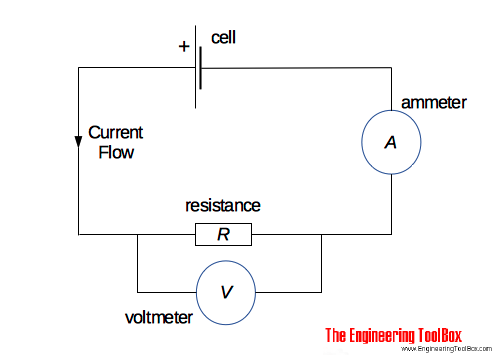Electrical Units
Definition of common electrical units - like Ampere, Volt, Ohm, Siemens.

Ampere - A
An ampere is the current which - if maintained in two straight parallel conductors of infinite length - of negligible circular cross section, and placed 1 meter apart in vacuum, would produce between these conductors a force equal to 2×10-7 Newton per meter of length.
Electric current is the same as electric quantity in movement, or quantity per unit time:
I = Q / t (1)
where
I = electric current (ampere, A)
Q = electric quantity (coulomb, C)
t = time (s)
A current of 1 amp equals a flow of 1 coulomb of charge per second.
Ampere can be measured with an "ammeter" in series with the electric circuit. Currents usually expressed in amperes (A), milliamperes (1 mA = 10−3 A), microamperes (1μA=10−6A), nanoamperes (1 nA = 10−9A), or picoamperes (1 pA = 10−12 A)
Coulomb - C
The standard unit of quantity in electrical measurements. It is the quantity of electricity conveyed in one second by the current produced by an electro-motive force of one volt acting in a circuit having a resistance of one ohm, or the quantity transferred by one ampere in one second.
Q = I t (2)
- 1 coulomb = 6.24×1018 electrons
Farad - F
The farad is the standard unit of capacitance. Reduced to base SI units one farad is the equivalent of one second to the fourth power ampere squared per kilogram per meter squared (s4A2/kg m2).
When the voltage across a 1 F capacitor changes at a rate of one volt per second (1 V/s) a current flow of 1 A results. A capacitance of 1 F produces 1 V of potential difference for an electric charge of one coulomb (1 C).
In common electrical and electronic circuits units of microfarads μF (1 μF = 10-6 F) and picofarads pF (1 pF = 10-12 F) are used.
Ohm - Ω
The derived SI unit of electrical resistance - the resistance between two points on a conductor when a constant potential difference of 1 volt between them produces a current of 1 ampere.
Henry - H
The Henry is the unit of inductance. Reduced to base SI units one henry is the equivalent of one kilogram meter squared per second squared per ampere squared (kg m2 s-2 A-2).
Inductance
An inductor is a passive electronic component that stores energy in the form of a magnetic field.
The standard unit of inductance is the henry abbreviated H. This is a large unit and more commonly used units are the microhenry abbreviated μH (1 μH =10-6H) and the millihenry abbreviated mH (1 mH =10-3 H). Occasionally, the nanohenry abbreviated nH(1 nH = 10-9 H) is used.
Joule - J
The unit of energy work or quantity of heat done when a force of one Newton is applied over a displacement of one meter. One joule is the equivalent of one watt of power radiated or dissipated for one second.
In imperial units the British Thermal Unit (Btu) is used to express energy. One Btu is equivalent to approximately 1,055 joules.
- A joule (J) of work is done in moving a coulomb (C) of charge through a potential difference of 1 V.
Siemens - S
The unit of electrical conductance S = A / V
Watt
The watt is used to specify the rate at which electrical energy is dissipated, or the rate at which electromagnetic energy is radiated, absorbed, or dissipated.
The unit of power W or joule/second
Weber - Wb
The unit of magnetic flux.
The flux that when linking a circuit of one turn, produces an Electro Motive Force - EMF - of 1 volt as it is reduced to zero at a uniform rate in one second.
- 1 Weber is equivalent to 108 Maxwells
Tesla - T
The unit of magnetic flux density the Tesla is equal to 1 Weber per square meter of circuit area.
Volt
The volt - V - is the Standard International (SI) unit of electric potential or electromotive force. A potential of one volt appears across a resistance of one ohm when a current of one ampere flows through that resistance.
Reduced to SI base units,
1 (V) = 1 (kg m2/ s3 A)
A "voltmeter" can be used to measure voltage and must be connected in parallel with the part of the circuit whose voltage is required.
The unit is the volt, with voltages usually expressed in volts (V), kilovolts (1 kV = 103 V), millivolts (1 mV = 10−3 V), or microvolts (1 μV = 10−6 V)



